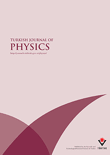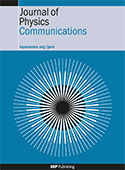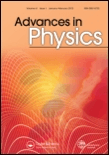
JETP LETTERS
Scope & Guideline
Connecting Ideas, Transforming Knowledge
Introduction
Aims and Scopes
- Condensed Matter Physics:
The journal covers a wide range of topics in condensed matter physics, including superconductivity, magnetism, and electronic properties of materials. Research in this area often employs theoretical and experimental methodologies to explore the behavior of materials at various temperatures and magnetic fields. - Quantum Optics and Photonics:
There is a significant emphasis on quantum optics, including studies on quantum entanglement, photon sources, and the manipulation of light at the quantum level. The journal publishes research that explores new optical phenomena and technologies that arise from quantum mechanical principles. - Nanostructures and Materials Science:
Research on the synthesis, characterization, and application of nanostructured materials is a key focus. This includes studies on the physical and chemical properties of nanomaterials, their interactions with light, and their potential use in advanced technologies such as sensors and quantum devices. - Plasma Physics and Magnetism:
The journal also addresses topics in plasma physics, including the behavior of plasmas in magnetic confinement systems and their interaction with electromagnetic fields. This research is crucial for advancing fusion energy technologies and understanding space physics. - Theoretical and Computational Physics:
JETP Letters features theoretical studies that contribute to the understanding of complex physical systems through computational modeling and analytical approaches. This includes research on quantum field theories, statistical mechanics, and simulations of condensed matter systems.
Trending and Emerging
- Topological Insulators and Quantum Materials:
There is a growing interest in topological insulators and quantum materials, particularly their unique electronic properties and potential applications in quantum computing and spintronics. - Advanced Nanostructures and Metamaterials:
Research on advanced nanostructures, including metamaterials that exhibit extraordinary optical properties, is on the rise, driven by their potential for applications in imaging, sensing, and telecommunications. - Superconductivity Research:
Superconductivity remains a hot topic, with a particular focus on high-temperature superconductors and novel superconducting materials that could revolutionize energy transmission and storage. - Quantum Computing and Information:
The field of quantum computing is increasingly represented, with studies exploring quantum memory, entanglement, and the development of qubits, reflecting the broader interest in quantum technologies. - Dynamic and Nonlinear Systems:
Research on dynamic and nonlinear phenomena in various physical systems is gaining prominence, including studies on solitons, wave propagation, and complex interactions, which are crucial for understanding emergent behaviors in materials.
Declining or Waning
- Classical Electromagnetism:
Research related to classical electromagnetism, including traditional wave propagation and classical optics, has seen a decline as more focus shifts towards quantum optics and photonics. - Simple Material Systems:
There appears to be a waning interest in studies dealing with simple or bulk material systems without complex interactions or novel properties, as researchers increasingly gravitate towards more intricate systems, such as heterostructures and nanomaterials. - Conventional Superconductors:
Research focusing solely on conventional superconductors, particularly those that do not exhibit novel or high-temperature superconductivity, has seen a decrease in favor of studies on unconventional superconductors and their exotic properties. - Static Magnetic Properties:
The study of static magnetic properties, which was once a vibrant area of research, is now less prevalent compared to dynamic phenomena and time-dependent processes in magnetism. - Basic Quantum Mechanics:
While foundational studies in quantum mechanics remain important, there is a noticeable shift towards applied quantum technologies and complex systems, resulting in fewer publications on basic theoretical aspects.
Similar Journals

Romanian Journal of Physics
Exploring the universe through rigorous research.Welcome to the Romanian Journal of Physics, a distinguished platform dedicated to advancing the field of physics and astronomy since its inception. Published by EDITURA ACAD ROMANE, this journal plays a pivotal role in disseminating high-quality research from Romania and around the globe, with an impressive impact factor that reflects its rigorous academic standards. With a focus on a broad range of topics in general physics and astronomy, it proudly maintains a Q2 ranking in its category for 2023, positioning itself among the top journals in the field. The journal, which has been converging valuable research contributions from 2008 until 2024, is accessible to a wide audience of researchers, professionals, and students interested in the latest developments and discoveries in physics. While it operates under a traditional publication model without Open Access, its commitment to quality research ensures that the contributions featured in its pages resonate well within the scientific community. We invite you to explore the rich findings published in the Romanian Journal of Physics and to engage with the vital discussions shaping the future of physics.

Physical Review Research
Empowering researchers with unrestricted access to knowledge.Physical Review Research, published by the American Physical Society, is a premier open access journal dedicated to the dissemination of high-quality research across all areas of physics and astronomy. Since its inception in 2019, this journal has quickly established itself as a vital platform for researchers, achieving a prestigious Q1 ranking in the dynamics of Physics and Astronomy (miscellaneous) and holding a commendable position in the Scopus Rankings with a rank of #29 out of 243, placing it in the 88th percentile. With the commitment to fostering scientific collaboration and transparency, Physical Review Research offers unrestricted access to valuable findings, enabling researchers, professionals, and students alike to engage with cutting-edge contributions in general physics and astronomy. As it converges into its forthcoming years of publication, the journal remains dedicated to showcasing rigorous research and innovative ideas that drive the field forward.

Frontiers of Physics
Advancing the Boundaries of Physics ResearchFrontiers of Physics, published by Higher Education Press, is a premier open-access journal dedicated to fostering innovative research and excellence within the field of physics. With an ISSN of 2095-0462 and an E-ISSN of 2095-0470, this rapidly growing journal has established itself as a valuable platform for disseminating cutting-edge findings, covering a diverse range of topics from theoretical frameworks to experimental advancements. Notably, Frontiers of Physics has achieved an impressive Q1 ranking in the 2023 Scopus Quartiles for Physics and Astronomy, securing a competitive 5th out of 81 positions in its category, reflecting a high impact factor that underscores its importance to the scientific community. Since its inception in 2011 and continuing through 2024, the journal aims to bridge the gap between academia and industry, encouraging collaboration among researchers, professionals, and students alike. Its commitment to open access ensures that high-quality research is readily accessible, thereby promoting knowledge sharing and advancement in the global physics community. Explore the potential of your research in Frontiers of Physics, where the future of physics flourishes.

REVISTA MEXICANA DE FISICA
Pioneering Insights in Physics and Educational MethodologiesREVISTA MEXICANA DE FISICA is a prominent academic journal dedicated to advancing knowledge in the fields of Physics and Education. Published by the SOC MEXICANA FISICA, this journal plays a pivotal role in disseminating innovative research and educational methodologies from Mexico and beyond. With a publication history that spans from 1991 to 2024, it has established itself as an essential resource for researchers, professionals, and students who seek to deepen their understanding of general physics and astronomy. The journal is classified in the Q3 quartile in both education and physics & astronomy, showcasing its quality and relevance within the academic landscape. While the journal currently operates on a subscription basis, it provides a valuable platform for emerging voices and established scholars alike. By fostering a collaborative environment for scientific discourse, REVISTA MEXICANA DE FISICA continues to be an important channel for the ongoing evolution of scientific education and exploration in the physical sciences.

Turkish Journal of Physics
Exploring the depths of physics and astronomy.Turkish Journal of Physics, established in 1994 and published by the Tubitak Scientific & Technological Research Council Turkey, is a prominent platform for the dissemination of innovative research in the field of physics and related areas. With an ISSN of 1300-0101 and an E-ISSN of 1303-6122, this journal has carved a niche in the academic community, evidenced by its ranking within the Q3 category in the 2023 evaluation of Physics and Astronomy. As it converges its published works toward the year 2024, researchers and scholars are encouraged to engage with its rich repertoire of studies that covers general physics and astronomy, currently holding a Scopus rank of #96 out of 243, placing it in the top 60th percentile. The Turkish Journal of Physics serves as a vital resource for advancing knowledge, fostering collaborative research, and providing insights into contemporary advancements in the discipline. While it operates under a subscription model, the quality and impact of its peer-reviewed articles make it an essential read for professionals and students alike, looking to stay informed on critical developments within the physics community.

Journal of Physics Communications
Unlocking the Future of Physics ResearchJournal of Physics Communications, published by IOP Publishing Ltd, serves as a significant platform for the dissemination of innovative research in the realm of physics and astronomy. Since its inception in 2017, this Open Access journal has fostered a collaborative environment, allowing researchers, professionals, and students to share their findings and ideas without barriers. With an ISSN of 2399-6528, the journal has established its credibility in the academic community, achieving a ranking of Q3 in the 2023 category of Physics and Astronomy (miscellaneous), as well as a respectable position in Scopus with a rank of #122 out of 243 in its field. The journal's focus is on bridging theoretical concepts and practical applications, making it an essential resource for those engaged in the evolving landscape of physics. The Journal of Physics Communications not only aims to advance knowledge but also to inspire interdisciplinary collaboration, inviting contributions from diverse areas within physics. Authors and readers alike will find this journal particularly beneficial to stay updated on emerging trends and innovative research.

ADVANCES IN PHYSICS
Connecting Ideas and Innovations in Physics.ADVANCES IN PHYSICS, published by TAYLOR & FRANCIS LTD, is a prestigious journal that has been at the forefront of condensed matter physics since its inception in 1952. With an impressive impact factor, the journal holds a prominent place in the academic community, classified as Q1 in the 2023 category for Condensed Matter Physics, and it ranks first among 434 journals in this field, demonstrating its value and influence. This journal provides a platform for cutting-edge research, encompassing theoretical, computational, and experimental studies that push the boundaries of knowledge in physics. Its commitment to high-quality publications makes it essential reading for researchers, professionals, and students alike. Although it does not offer open access, ADVANCES IN PHYSICS remains a critical resource for those aiming to stay updated with significant developments in condensed matter physics, fostering innovation and collaboration across disciplines.

Condensed Matter
Pioneering Discoveries in Condensed Matter ScienceCondensed Matter is a leading open-access journal dedicated to the diverse and dynamic field of condensed matter physics, published by MDPI since 2016. With its base in Switzerland, the journal aims to present a platform for researchers and professionals to share innovative findings and advancements in areas such as electronic, optical, and magnetic materials. As of 2023, it is ranked in the Q3 category for both condensed matter physics and electronic, optical, and magnetic materials, a testament to its relevance and growth within the scientific community. Researchers will find valuable insights through its accessible format, fostering collaboration and knowledge dissemination within this interdisciplinary field. With a commitment to enhancing the global dialogue in condensed matter studies, Condensed Matter invites contributions that explore theoretical and experimental approaches, thus pushing the boundaries of understanding in this crucial area of science.

CHINESE PHYSICS LETTERS
Your Gateway to High-Impact Physics ResearchChinese Physics Letters is a prestigious journal published by IOP Publishing Ltd, based in the United Kingdom. Since its inception in 1984, the journal has served as a vital platform for disseminating impactful research in the field of physics, achieving a noteworthy Q1 ranking in the category of Physics and Astronomy (miscellaneous) as of 2023. Renowned for its rapid publication process, this journal is dedicated to providing a forum for high-quality, concise articles that address innovative theoretical and experimental findings relevant to both the academic community and industry practitioners. With an impressive Scopus rank of #52 out of 243, placing it in the 78th percentile, Chinese Physics Letters continues to influence the global physics landscape. Researchers, professionals, and students alike find this journal indispensable for staying abreast of the latest developments and trends in physics.

ACTA PHYSICA POLONICA A
Pioneering Insights in the Evolving World of PhysicsACTA PHYSICA POLONICA A is a distinguished peer-reviewed journal published by the Polish Academy of Sciences Institute of Physics, offering a platform for disseminating cutting-edge research in the field of physics and astronomy. With an ISSN of 0587-4246 and an E-ISSN of 1898-794X, this journal has been a staple for scholars since its inception, converging its publication years from 1996 to 2024. Despite its current Q4 classification in the Physics and Astronomy (miscellaneous) category, ACTA PHYSICA POLONICA A provides valuable insights and breakthroughs addressing various aspects of general physics. Researchers, professionals, and students will find a wealth of knowledge within its pages, even as it operates in an evolving academic landscape. While subscription options exist, the journal aims to foster collaboration and knowledge exchange in the physics community, making it a vital resource for those seeking to stay at the forefront of research advancements.